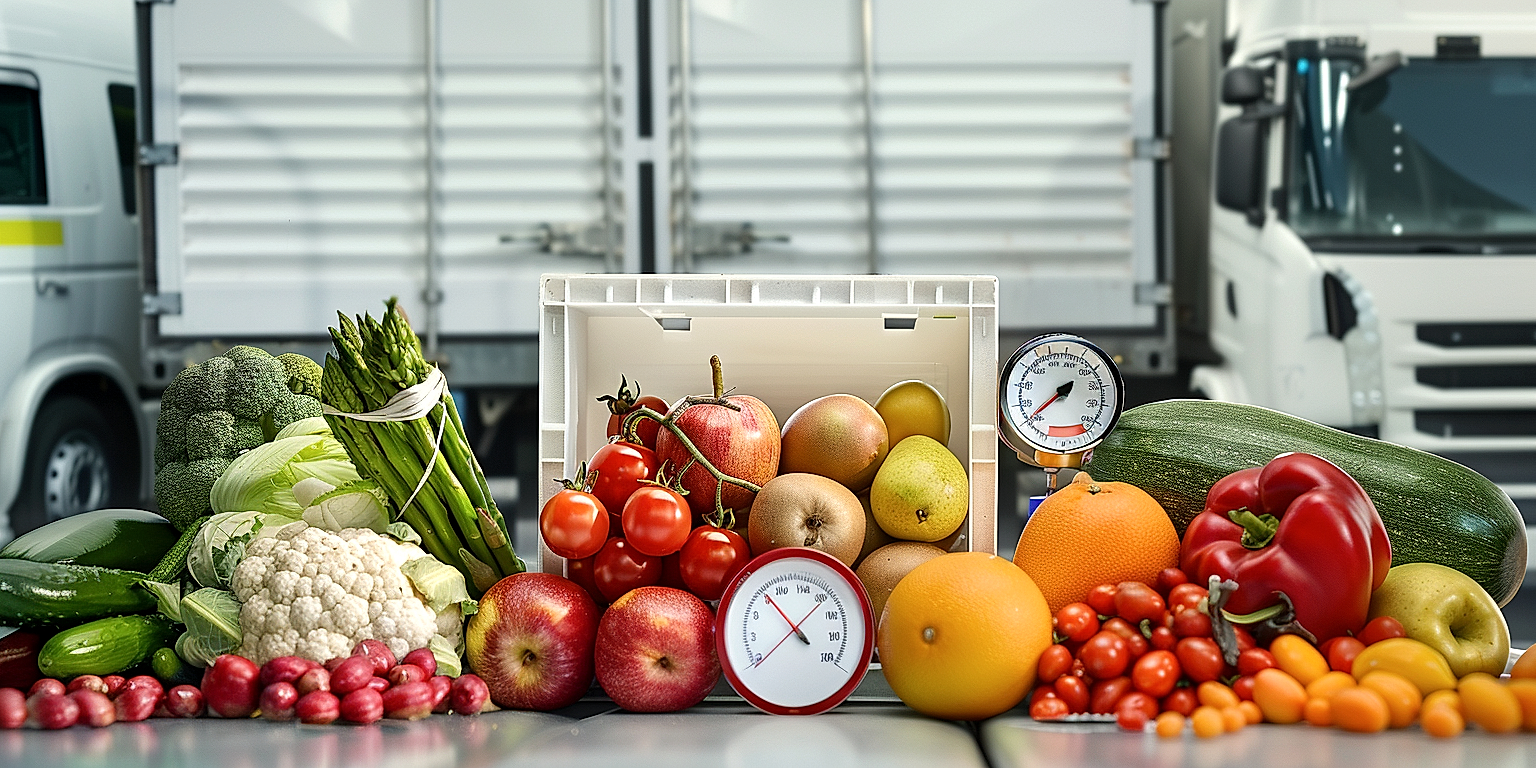Within the complex ecosystem of modern agriculture, one element that often goes unnoticed is the sophisticated technology driving produce shipping operations.
Over the past few years, we have witnessed substantial changes in the industry aimed at bolstering food safety measures.
Strategic deployment of technology is now paramount in ensuring unparalleled levels of quality control in produce transit.
Moreover, these implementations have a crucial role in minimizing contamination risks.
Unsurprisingly, shippers, retailers and consumers stand to benefit tremendously from these enhancements.
In this article, we explore some of the groundbreaking technologies that are revolutionizing the realm of produce shipping.
Contents
Technologies Enhancing Safety In Produce Shipping Operations
1. Real-Time Temperature Monitoring Systems
Transactions dealing with shipping operations, especially those dealing with perishable goods like produce, rely heavily on effective temperature control mechanisms.
When the temperature isn’t appropriately monitored and controlled, it could lead to substantial product loss, escalating costs, and reduced consumer trust.
Therefore, implementing Real-Time Temperature Monitoring Systems forms a pivotal part of enhancing safety in produce shipping operations.
These state-of-the-art systems continually monitor the temperature, ensuring produce remains at an optimal temperature throughout their transit journey.
Unlike traditional temperature monitoring, which merely records temperature data at specific intervals, these advanced systems provide real-time updates, thereby ensuring a better control and more detailed insights.
These systems are typically equipped with various types of sensors that record temperature, relative humidity, and other essential parameters.
The sensors can transmit data wirelessly to a centralized location where it can be accessed for continuous monitoring.
This constant stream of data allows the stakeholders to take immediate corrective actions whenever there is a variation beyond the acceptable limits.
Equipped with powerful alert mechanisms, these systems can send notifications to the relevant personnel if the temperature exceeds set thresholds.
This capability provides ample time to detect and correct potential issues before they escalate to product loss.
Besides, the temperature data gathered by these systems can also be analyzed later to identify patterns and trends that can help optimize the supply chain.
Additionally, real-time temperature monitoring systems also significantly reduce the chances of food-borne illnesses that can manifest due to the improper storage of food items.
By ensuring that the temperature conditions are always within the allowed range, the growth of harmful bacteria and other pathogens can be effectively prevented, thereby reducing the risk of food-borne illnesses.
Available in various forms depending on the specific requirements of the produce to be shipped, these systems can be easily integrated into existing shipping facilities.
In conclusion, Real-Time Temperature Monitoring Systems not only ensure efficient management of produce shipping but also significantly enhance the safety aspects of the entire process.
2. Automated Packaging and Sorting Machines
The advent of automated packaging and sorting machines has extensively transformed the produce shipping operations by enhancing safety measures.
These advanced, technology-driven devices have eliminated the significant risks associated with manual handling of produce.
Equipped with evolved AI technology, they can detect any physical damages or potential risks related to the produce, ensuring a superior quality control mechanism.
Machine automation in packaging and sorting has offered not only speed and accuracy but also a safer environment for handling produce.
Their ability to work at high speed has exponentially increased the efficiency of shipping operations, aiding faster delivery times.
Further, advanced sensors incorporated in these machines prevent mishandling of produce, thereby reducing the chances of damage and ensuing health risks.
Automated systems can operate around the clock with minimal supervision, providing an around-the-clock operation without compromising safety norms.
Moreover, their precision in packaging and sorting ensures a lower likelihood of cross-contamination, thereby preserving the integrity and safety of the produce.
Automated machines also contribute to making the shop floor safer by minimizing manual handling, thereby reducing workplace injuries.
Explicitly designed to handle produce delicately, these machines provide excellent care in packaging, ensuring the produce arrives fresh and intact.
Their ability to sort produce based on weight, size, and quality implies a consistent flow of quality checked products, maintaining the safety standards of shipping operations.
Furthermore, they ensure traceability by labeling and engraving batch numbers, use-by dates, and origin on the produce packages, thereby enhancing consumer trust and confidence.
By generating predictive analytics, these machines help shipping operations to avoid potential quality pitfalls and hazardous situations in the process.
Lastly, automated packaging and sorting systems can be integrated with IoT and AI-powered tools for a more coherent, streamlined, and safe shipping process.
3. AI-Powered Quality Inspection Systems
As the produce shipping industry pushes towards optimization, the application of AI-Powered Quality Inspection Systems is becoming increasingly popular.
These systems are designed to use advanced algorithms and machine learning to conduct thorough examination of produce while maintaining a fast-paced workflow.
By doing so, AI technology helps to eliminate the margin for error associated with human judgement.
In produce shipping, product quality and safety are of utmost importance, hence, AI provides an unmatched level of accuracy and consistency in inspections.
In addition to recognizing potential hazards, these inspections systems are capable of predicting future quality issues allowing for proactive measures.
Leading companies in the industry are now investing heavily in AI technology due to its ability to enhance overall operational efficiency.
The AI-powered quality inspection process involves several stages starting with the acquisition of high-resolution images of produce.
Following this, AI algorithms are used to analyze the images, scrutinizing each detail minutely.
The system then accurately identifies any defects or anomalies in the produce.
Notably, this automation minimizes production delays and amplifies the rate of produce inspection.
Furthermore, the data collected by the AI system can equip businesses with valuable insights for improving their quality control mechanisms.
By implementing AI-powered quality inspection systems, businesses can drastically increase the safety and quality of their produce.
These technologies provide a distinct advantage as they allow for real-time decision making, a capability not possible with traditional inspection methods.
Through AI, shipping companies can maintain high safety standards while facilitating a faster flow of goods.
As businesses continue to incorporate AI into their quality inspection systems, we can expect a significant enhancement in the safety and efficiency of produce shipping.
The introduction of such technologies into the produce shipping industry will likely transform operational procedures drastically over the coming years.
4. IoT-enabled Tracking and Tracing Tools
Internet of Things (IoT) technology plays a crucial role in enhancing safety in produce shipping operations.
IoT-enabled tracking and tracing tools offer real-time visibility into the movement and condition of products, from the point of origin to the final destination.
These tools can monitor the temperature, humidity levels, and other environmental conditions of the products while they are in-transit.
This kind of detailed tracking and monitoring not only reduces the risk of spoilage or damage to the products, but also helps in identifying bottlenecks or inefficiencies in the supply chain.
An IoT-based tracking system typically includes sensors, connectivity technologies, and software applications that capture and analyze data.
Some of these IoT devices are even equipped with GPS capabilities that provide precise location tracking of the shipments.
These tools provide insights into transit times, route efficiencies, and delivery predictions which facilitate better decision making.
They play a vital role in facilitating recalls if a particular batch of products is found to be contaminated or unfit for consumption.
Moreover, IoT-enabled tracking tools can alert the stakeholders in case of any deviations from the set conditions, allowing for immediate corrective action.
These tools have the ability to collect a vast amount of data from different stages of the supply chain, which can be used to derive meaningful insights and improve operations.
Equipping shipping containers or pallets with IoT sensors can help shippers track multiple parameters of a product during transit, leading to improved safety and quality.
Furthermore, through the use of IoT, barriers such as global time zone differences and lack of transparency can be significantly reduced.
The implementation of IoT in shipping operations is seen as a bright prospect for increasing supply chain efficiency and transparency.
Through the use of IoT, shipping companies can gain better control over their operations, which in turn enhances safety and reduces product wastage.
5. Blockchain for Supply Chain Transparency
One of the groundbreaking technologies enhancing safety in produce shipping operations is blockchain, particularly for its application in fostering supply chain transparency.
Traditionally, supply chains have struggled with the challenge of achieving full transparency due to the convoluted and multi-tiered nature of these networks.
The integration of blockchain technology in these operations is revolutionizing the way transparency is achieved, offering a higher level of confidence in safety and quality measures.
At the core of blockchain’s advantages is its ability to create and maintain a decentralized and immutable ledger of all transactions along the supply chain.
This record provides an impeccable degree of traceability, enabling stakeholders to verify the origin and journey of produce, swiftly and unerringly.
From growers, processors, transporters, and retailers, each actor involved leaves a clear digital footprint on the product’s journey, promoting transparency and accountability in the supply chain.
This transparency not only enhances the safety of produce shipping operations but also augments consumers’ trust in the products they consume.
Should a safety concern arise, the immutable ledger provided by the blockchain can efficiently pinpoint the source of the problem, preventing further distribution of unsafe produce.
Furthermore, blockchain technology enables supply chain stakeholders to gain real-time visibility into the operation’s status and the conditions of goods.
This visibility assists in safeguarding the quality and freshness of the produce during transit, optimizing stock management and reducing wastages.
By ensuring that relevant information is readily available, delays are minimized, and the efficiency of produce shipping operations is enhanced.
Equally important, blockchain serves to digitally certify the compliance of processes and products with safety regulations and quality standards.
This certification is verifiable and unalterable, providing further assurance of the safety measures implemented throughout the supply chain.
Lastly, blockchain technology facilitates more efficient recalls, should they be necessary, by providing a precise and prompt method of identifying and locating affected products.
In the interest of public health, this aspect is vital as rapid action is crucial to prevent consumption of potentially hazardous produce.
Clearly, blockchain technology is an emerging game-changer in enhancing the safety and efficiency of produce shipping operations.
The Bottom Line
Considerable advancement in technology is rapidly modernizing the logistics and supply chain industry.
Real-time temperature monitoring systems, improved automation in packaging and sorting machines, AI-powered quality inspection systems, IoT-enabled tracking tools, and blockchain technology are revolutionizing how businesses operate.
These technological innovations enhance efficiency, offer precise tracking, promote transparency, and ensure the delivery of high-quality products.
Keeping pace with these changes is integral for companies aiming to sustain and improve their market position in the future.
The adoption of these technologies in supply chains, thus, is not merely a trendy option but a competitive necessity in today’s digital age.




